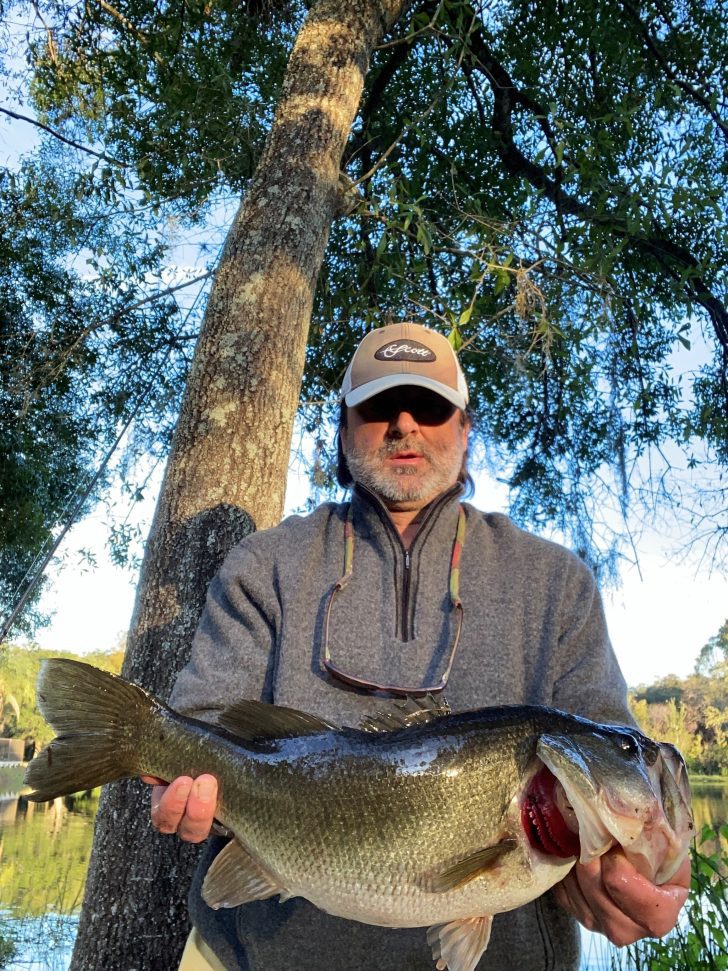NOTE FROM THE EDITOR:
In Mr. Broer’s last piece, Tilapia On Fly (February) there was a layout error that resulted in the first paragraph of his Crappie On Fly story (January) being inserted into the beginning of the February piece. We apologize for any confusion this may have caused.
Florida is known for having large lakes that hold big bass; but, some smaller, lesser-fished ponds, might hold monsters you wouldn’t think are there. These largemouth, or black bass (Micropterus salmoides, scientifically speaking) could be in your backyard pond, or in a tiny retention pond on the side of the road. The term “ditch pickle” is used for that reason–even dirty, shallow ditches can hold double-digit bass.
I’ve lived on lakes throughout the years, but my personal best did not come from a lake. My PB came from a small retention pond just down the road. Because many of these ponds are on private property, or deemed “NO FISHING,” be careful to follow the laws of the land. But, if they are open to the public, give it a shot.
I’m lucky in that the pond I live on is a spit away from my front door. It’s easy to wet a line almost every day to increase my odds. But, it’s not my pond in which I’ve landed the majority of my big bass. It’s that dirty, often algae-filled little ditch on the side of the road that’s produced bigger fish. I suppose the big fish in these ponds get that way, because they are overlooked or not harvested. Most of these small, roadside bodies of water are runoff/retention ponds, so you would NOT want to eat fish from them. From time to time, I eat freshwater bass, but not from these haunts.
When I’m scouting new ponds for big bass missions, I often put down the fly rod and bust out my bait casters. This allows me to cover a lot of water quickly. I look for a few things: enough water to hold fish, fish movement, bait, and birds (which suggests the presence of bait).
I arm my bait-casting rigs with plastic worms, frogs, and a bladed jig or fluke. Many of these ponds are too shallow for diving plugs, so shallower running baits are best. With this arsenal, you will find a bait that will find the fish. If you see duckweed or heavy lily pad cover, throw the frog. For the deeper ponds, nothing can beat slow dragging a plastic worm across the bottom. Whether it’s an old-school, curly-tailed worm, or a more modern Senko worm, you can’t go wrong with the tried-and-true worm technique. If I see bait being chased, I’ll switch to a fluke, chatter-bait or Rat-L Trap, if the water is deep enough.
In the Tampa Bay area, with the number of housing developments, apartments/condos and shopping centers, there are endless retention ponds. When these communities and businesses are designed, a retention pond is usually part of the plan. This is especially true of lower lying areas. While I’m not a big fan of the population explosion in our area, one small consolation is the addition of fishy ponds. Again, please use common sense and civility when choosing a place to fish. If there are “no trespassing” and/or “no fishing” signs, you should probably move on.
Spring and early Summer are perfect for this small pond mission, so grab a rod or two, hop in your car and explore. The Tampa Bay area is a true hotspot for catching big bass in small ponds. And, the next time you’re at your local tackle shop, talk to the bass guys and gals there. They’ll definitely be able to suggest a great bait, and maybe even some local knowledge.

